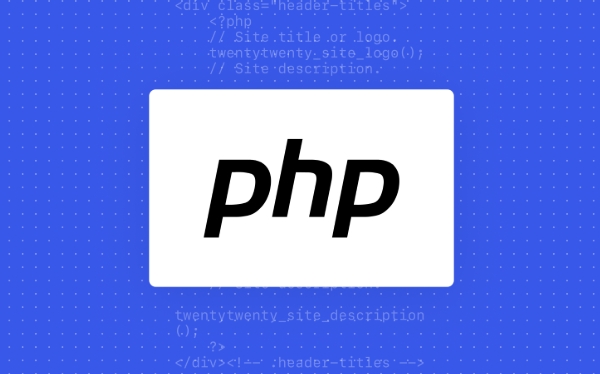 Backend Development
Backend Development
 PHP Tutorial
PHP Tutorial
 Demystifying foreach Behavior with Public vs. Private Object Properties
Demystifying foreach Behavior with Public vs. Private Object Properties
Foreach only accesses public properties when traversing objects in PHP; 2. Protected and private properties are not visible, even if you use foreach($this as...) inside the class; 3. To customize the traversal behavior, you can implement the Iterator or IteratorAggregate interface; 4. To check for properties that include private and protected, you need to use the Reflection class; 5. get_object_vars() also returns only the public properties under the current scope. Therefore, foreach's behavior is the embodiment of PHP encapsulation characteristics, and non-public attributes will not be traversed.

When working with objects in PHP and using foreach to iterate over their properties, you might notice that the behavior changes depending on whether properties are public, private, or protected. This can be confusing — especially if you're expecting foreach to behave like it does with arrays. Let's clarify how foreach interacts with object properties and why visibility matters.

How foreach Iterates Over Object Properties
In PHP, when you use foreach on an object, only public properties are accessible by default . This is a key difference from iterating over arrays, where all elements are visible.
Consider this simple class:

class User {
public $name = 'Alice';
protected $age = 30;
private $salary = 50000;
}Now, let's iterate over an instance:
$user = new User();
foreach ($user as $key => $value) {
echo "$key: $value\n";
}Output:

name: Alice
Only the public property name shows up. The protected and private properties are completely invisible to foreach .
Why Does This Happen?
PHP's foreach operates on the public interface of an object. When you iterate over an object, PHP doesn't directly access the internal structure. Instead, it follows visibility rules strictly — just like any other context in object-oriented programming.
This means:
-
publicproperties: accessible and iterable. -
protectedproperties: not accessible from outside the class or its children, so skipped. -
privateproperties: only accessible within the class itself, so also skipped.
Even if you're inside a method of the class, foreach($this as ...) will still only show public properties — which often surprises developers.
class User {
public $name = 'Alice';
private $salary = 50000;
public function debug() {
foreach ($this as $key => $value) {
echo "$key: $value\n"; // Only prints 'name'
}
}
} Yes — even from inside the class, foreach ignores private and protected properties.
Controlling Iteration with Iterator Interface
If you need to expose non-public properties (or any custom data) during iteration, you can implement the Iterator or IteratorAggregate interface.
For example, using IteratorAggregate :
class User implements IteratorAggregate {
public $name = 'Alice';
protected $age = 30;
private $salary = 50000;
public function getIterator(): Traversable {
return new ArrayIterator([
'name' => $this->name,
'age' => $this->age,
'salary' => $this->salary
]);
}
} Now, foreach will show all three:
foreach ($user as $key => $value) {
echo "$key: $value\n";
}Output:
name: Alice age: 30 Salary: 50000
This gives you full control over what appears during iteration — useful for debugging, serialization, or APIs.
Common Pitfalls and Tips
- Don't assume
foreachsees all properties — it doesn't. It only sees public ones. - Even inside a class,
foreach($this as ...)skips private/protected. - If you're debugging and wonder why some properties aren't showing up, check visibility.
- Use
var_dump()orget_object_vars()for complete property inspection:
var_dump(get_object_vars($user)); // Shows public properties only
Note: get_object_vars() also only returns publicly visible properties in the current scope.
To access private/protected properties, you'd need to use Reflection:
$reflection = new ReflectionObject($user);
$properties = $reflection->getProperties();
foreach ($properties as $prop) {
echo $prop->getName() . ': ' . $prop->getValue($user) . "\n";
}Summary
-
foreachon objects only iterates over public properties. - Visibility rules apply strictly — even from inside the class.
- Use
IteratorAggregateorIteratorto customize whatforeachexposes. - For full introduction (including private), use
Reflection.
Understanding this behavior helps avoid confusion when objects don't "loop through" as expected. It's not a bug — it's PHP enforcing encapsulation, one loop at a time.
Basically, if it's not public, foreach won't see it.
The above is the detailed content of Demystifying foreach Behavior with Public vs. Private Object Properties. For more information, please follow other related articles on the PHP Chinese website!

Hot AI Tools

Undress AI Tool
Undress images for free

Undresser.AI Undress
AI-powered app for creating realistic nude photos

AI Clothes Remover
Online AI tool for removing clothes from photos.

Clothoff.io
AI clothes remover

Video Face Swap
Swap faces in any video effortlessly with our completely free AI face swap tool!

Hot Article

Hot Tools

Notepad++7.3.1
Easy-to-use and free code editor

SublimeText3 Chinese version
Chinese version, very easy to use

Zend Studio 13.0.1
Powerful PHP integrated development environment

Dreamweaver CS6
Visual web development tools

SublimeText3 Mac version
God-level code editing software (SublimeText3)
 PHP Variable Scope Explained
Jul 17, 2025 am 04:16 AM
PHP Variable Scope Explained
Jul 17, 2025 am 04:16 AM
Common problems and solutions for PHP variable scope include: 1. The global variable cannot be accessed within the function, and it needs to be passed in using the global keyword or parameter; 2. The static variable is declared with static, and it is only initialized once and the value is maintained between multiple calls; 3. Hyperglobal variables such as $_GET and $_POST can be used directly in any scope, but you need to pay attention to safe filtering; 4. Anonymous functions need to introduce parent scope variables through the use keyword, and when modifying external variables, you need to pass a reference. Mastering these rules can help avoid errors and improve code stability.
 How to handle File Uploads securely in PHP?
Jul 08, 2025 am 02:37 AM
How to handle File Uploads securely in PHP?
Jul 08, 2025 am 02:37 AM
To safely handle PHP file uploads, you need to verify the source and type, control the file name and path, set server restrictions, and process media files twice. 1. Verify the upload source to prevent CSRF through token and detect the real MIME type through finfo_file using whitelist control; 2. Rename the file to a random string and determine the extension to store it in a non-Web directory according to the detection type; 3. PHP configuration limits the upload size and temporary directory Nginx/Apache prohibits access to the upload directory; 4. The GD library resaves the pictures to clear potential malicious data.
 Commenting Out Code in PHP
Jul 18, 2025 am 04:57 AM
Commenting Out Code in PHP
Jul 18, 2025 am 04:57 AM
There are three common methods for PHP comment code: 1. Use // or # to block one line of code, and it is recommended to use //; 2. Use /.../ to wrap code blocks with multiple lines, which cannot be nested but can be crossed; 3. Combination skills comments such as using /if(){}/ to control logic blocks, or to improve efficiency with editor shortcut keys, you should pay attention to closing symbols and avoid nesting when using them.
 How Do Generators Work in PHP?
Jul 11, 2025 am 03:12 AM
How Do Generators Work in PHP?
Jul 11, 2025 am 03:12 AM
AgeneratorinPHPisamemory-efficientwaytoiterateoverlargedatasetsbyyieldingvaluesoneatatimeinsteadofreturningthemallatonce.1.Generatorsusetheyieldkeywordtoproducevaluesondemand,reducingmemoryusage.2.Theyareusefulforhandlingbigloops,readinglargefiles,or
 Tips for Writing PHP Comments
Jul 18, 2025 am 04:51 AM
Tips for Writing PHP Comments
Jul 18, 2025 am 04:51 AM
The key to writing PHP comments is to clarify the purpose and specifications. Comments should explain "why" rather than "what was done", avoiding redundancy or too simplicity. 1. Use a unified format, such as docblock (/*/) for class and method descriptions to improve readability and tool compatibility; 2. Emphasize the reasons behind the logic, such as why JS jumps need to be output manually; 3. Add an overview description before complex code, describe the process in steps, and help understand the overall idea; 4. Use TODO and FIXME rationally to mark to-do items and problems to facilitate subsequent tracking and collaboration. Good annotations can reduce communication costs and improve code maintenance efficiency.
 Quick PHP Installation Tutorial
Jul 18, 2025 am 04:52 AM
Quick PHP Installation Tutorial
Jul 18, 2025 am 04:52 AM
ToinstallPHPquickly,useXAMPPonWindowsorHomebrewonmacOS.1.OnWindows,downloadandinstallXAMPP,selectcomponents,startApache,andplacefilesinhtdocs.2.Alternatively,manuallyinstallPHPfromphp.netandsetupaserverlikeApache.3.OnmacOS,installHomebrew,thenrun'bre
 How to access a character in a string by index in PHP
Jul 12, 2025 am 03:15 AM
How to access a character in a string by index in PHP
Jul 12, 2025 am 03:15 AM
In PHP, you can use square brackets or curly braces to obtain string specific index characters, but square brackets are recommended; the index starts from 0, and the access outside the range returns a null value and cannot be assigned a value; mb_substr is required to handle multi-byte characters. For example: $str="hello";echo$str[0]; output h; and Chinese characters such as mb_substr($str,1,1) need to obtain the correct result; in actual applications, the length of the string should be checked before looping, dynamic strings need to be verified for validity, and multilingual projects recommend using multi-byte security functions uniformly.
 Learning PHP: A Beginner's Guide
Jul 18, 2025 am 04:54 AM
Learning PHP: A Beginner's Guide
Jul 18, 2025 am 04:54 AM
TolearnPHPeffectively,startbysettingupalocalserverenvironmentusingtoolslikeXAMPPandacodeeditorlikeVSCode.1)InstallXAMPPforApache,MySQL,andPHP.2)Useacodeeditorforsyntaxsupport.3)TestyoursetupwithasimplePHPfile.Next,learnPHPbasicsincludingvariables,ech





